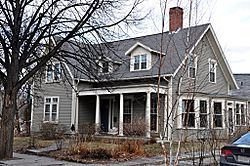Area less than one acre MPS Brookline MRA Opened 1844 | Built 1844 (1844) NRHP Reference # 85003249 Added to NRHP 17 October 1985 | |
 | ||
Similar Larz Anderson Auto Mus, Temple Ohabei Shalom, Coolidge Corner Theatre, Church of Our Saviour, Holyhood Cemetery | ||
The William Ingersoll Bowditch House is a historic house at 9 Toxteth Street in Brookline, Massachusetts. It is a good example of vernacular Gothic and Greek Revival architecture, built c. 1844-45 as part of one of Brookline's earliest formal residential subdivisions. William Bowditch, the first owner, was an active abolitionist who sheltered fugitive slaves as part of the Underground Railroad. The house was listed on the National Register of Historic Places in 1985.
Description and history
The William Ingersoll Bowditch House stands in a residential area northeast of the commercial area of Brookline Village, on the east side of Toxteth Street near its southern end. It faces west toward Linden Square. It is a 1-1/2 story wood frame structure, with an L-shaped plan, cross-gabled roof, and clapboarded exterior. A single-story shed-roof porch is located in the crook of the L. The windows under the porch are of full length, and the main entrance, also under the porch, has flanking full-length sidelight windows. Window openings are framed by drip moulding, and the roof is adorned with dormers that have steeply pitched roofs in the Gothic style.
The Linden Square area was subdivided in the 1840s by Thomas Aspinwall Davis on family farmland, its layout designed by Alexander Wadsworth. This house was built on land from several parcels in the subdivision in 1844-45 for William Ingersoll Bowditch, who lived here until 1867. Bowditch was active in local politics, serving on the board of selectmen and as moderator of the town meeting. Before the American Civil War he was an ardent abolitionist, serving on Boston's vigilance committee, which assisted fugitive slaves. Bowditch is documented to have sheltered at least one fugitive couple, and also hosted the son of John Brown.
